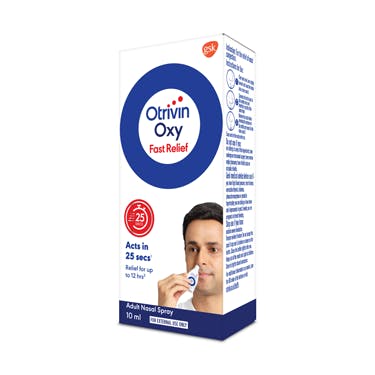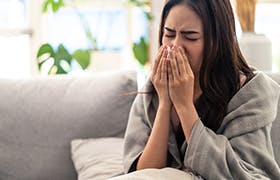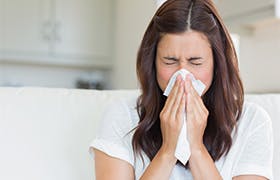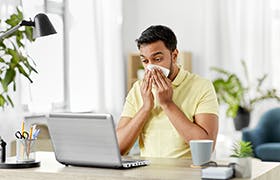
What is the science behind a cold?
Most adults will catch a cold two or three times a year and for children it can be up to six times a year,1 but did you ever wonder what exactly a cold is? Simply put, a cold is a viral infection caused by a wide range of viruses, with the rhinovirus family being the most common cause.1
While having a cold is certainly annoying, it usually doesn’t take long to clear up. Symptoms generally start to ease after a few days and disappear within a week. A person can be contagious from the day before the illness breaks out and can remain infectious for several weeks. Symptoms typically appear two to three days after infection.1
What is a cold?
A cold is a viral infection of your nose and throat (the upper respiratory tract). Many types of virus can cause a cold, but they are most commonly caused by viruses from the rhinovirus family. There are over 100 subtypes of rhinovirus – about half of all colds are associated with rhinoviruses, and this proportion can increase to 80% in the autumn.1
A cold virus enters your body through your mouth, eyes or nose. It can also spread through droplets in the air, or through direct or indirect contact with an infected person, object or surface. Once in the body, viruses use their own chemical and genetic strategies to escape your body’s natural defence systems.2
In response to a virus, your body’s immune system will spring into action: white blood cells, antibodies and other mechanisms work to rid your body of the virus. Indeed, many of the symptoms that make a person feel ill during a cold (fever, headache, tiredness) results from the activities of the immune system trying to eliminate the infection from the body.2
What are the symptoms of a cold?
Common cold symptoms include a sore throat, cough, tiredness, sneezing, or a blocked nose.5 Having a blocked nose can be one of the most annoying symptoms of a cold. It makes the simple act of breathing difficult, resulting in a lack of sleep and disrupted sleep patterns.1
How can I recognise that I’ve got a cold?
Colds symptoms and their severity will differ from person to person but, generally, you’ll start to feel symptoms between one and three days after infection, reaching a peak around day four.
Symptoms will usually start to taper off after seven days, but you can be contagious before you start to feel ill and for some time afterwards.3
- Days 1–3: You might feel more tired than usual, and feel the first signs of a sore throat (perhaps just an itchy throat) and you’ll probably start sneezing
- Days 3–5: Next, you’ll start to notice that your nose is blocked, being at its worst on days 3 and 4. You may also have a runny nose and a cough. Often the cough may linger for a few weeks after the blocked nose and other cold symptoms start to go away
- Days 6–7: You should be starting to feel better and most of your symptoms will be clearing up
- Longer term: If you still have symptoms after 7–10 days or your symptoms start to worsen, it might be worth visiting your doctor to rule out a sinus infection or allergies3
How does someone catch a cold?
An infected person can spread their cold viruses widely, either through coughs and sneezes (the virus can stay in the air for some time) or through directly touching other people or surfaces and leaving infected secretions, which are then transmitted to someone else when they touch their eyes, mouth or nose.4
What increases my risk of getting a cold?
These factors can increase your chances of getting a cold:1,4
- Age: younger children are at greatest risk of colds
- The time of year
- Smoking
- Exposure to other people with cold
- Stress
How do I treat a cold?
Rest is one of the best ways of treating a cold.1 Cold treatment mainly focusses on relieving the symptoms. For example, treatments of nasal congestion include nasal irrigation, steam treatments, or decongestant nasal sprays.
There are various products in the market such as Otrivin nasal sprays and drops to help unblock a congested nose caused by a cold, so you can breathe more easily again. The Otrivin range includes:
- Otrivin Oxy Fast Relief Nasal Spray, which starts to unblock your nose in just 25 seconds and provides relief for 12 hours.10
- Otrivin Paediatric Nasal Drops, which help to unblock your child’s (ages 1-11 years) congested nose and get to work in just 2 minutes and provides relief up to 12 hours.11
- Otrivin Saline Nasal Spray, which helps to wash away excess mucus produced during a cold.12
- Otrivin Baby Saline, which helps to provide relief from blocked nose in infants and toddlers.13
- Otrivin Moisturising Paediatric Nasal Drops & Otrivin Moisturising Adult Nasal Drops, helps to provide relief from congestion, and provides further moisturisation to the nasal passage. It starts working in 2 minutes and provides relief up to 12 hours.14,15
- Otrivin Breathe Clean can be used for daily nasal cleaning. It is a nasal wash that helps to clean pollutants, germs, and allergens from the nasal passage thus maintaining nasal health.16
You should always ask your doctor, which Otrivin product is best suited for your condition before initiating a treatment.
Healthy habits while you have a cold.1
- Get lots of rest and sleep
- Eat healthy foods
- Drink lots of fluids
- Wash your hands frequently
- Don’t share towels, toys or other objects
Vitamin and mineral supplement.
Another thing you can do is to incorporate certain vitamins and minerals in your diet. You can introduce fruits and vegetables with more vitamin C. Studies have shown that vitamin C could reduce the duration of the cold8
You can also speak to your doctor about taking zinc supplements at the first sign of a cold. In 2017, an analysis of seven studies showed that zinc supplementation could help to reduce the duration of a cold; the study participants took zinc lozenges and reduced the length of their colds by 33%.9
Make sure you speak to your doctor before taking any supplements, and any potential side effects before adding it to your recovery plan. The dosage and duration of supplement intake should be strictly according to the doctor’s advice.

*Global Datasheet Oxymetazoline Hydrochloride, Pritchard S Glover M, et al. Effectiveness of 0.05% oxymatazoline nasal spray in the treatment of objective nasal congestion demonstrated to 12 h post- administration by magnetic resonance imaging. Pulmonary Pharmacology & Therapueutics 2014; 27: 121-6
References:
- NICE CKS. Common cold. Available from: https://cks.nice.org.uk/common-cold#!background (last accessed March 2020)
- Drexler M. What You Need to Know About Infectious Disease. Institute of Medicine: National Academies Press (US); 2010. Available from: https://www.ncbi.nlm.nih.gov/books/NBK209710/ (last accessed March 2020)
- Symptoms of a Cold: Coughing, Runny Nose, No Fever, and More (webmd.com)
- Heikkinen T, Järvinen A. The common cold. Lancet 2003;361:51–59
- Eccles, R. 2009. Mechanisms of symptoms of common cold and flu. In Common Cold, Eccles & Weber, eds. Basel, Birkhäuser, 2009;23–45
- Eskiizmir G, Hirçin Z, Özyurt B, et al. A comparative analysis of the decongestive effect of oxymetazoline and xylometazoline in healthy subjects. Eur J Clin Pharmacol. 2011;67:19–23
- Pneumatikos I, Konstantonis D, Tsagaris I, et al. Prevention of nosocomial maxillary sinusitis in the ICU: the effects of topically applied α-adrenergic agonists and corticosteroids. Intens Care Med. 2006;32:532–537
- Hemilä H, Chalker E. Vitamin C for preventing and treating the common cold. Cochrane Database of Systematic Reviews 2013, Issue 1. Art. No: CD000980. Available from: DOI: 10.1002/14651858.CD000980.pub4. (last accessed March 2020)
- Hemilä H. Zinc lozenges and the common cold: a meta-analysis comparing zinc acetate and zinc gluconate, and the role of zinc dosage. J Royal Soc Med Open 2017;8:1–7
- Otrivin Oxy Fast Relief Nasal Spray Product Information Leaflet
- Otrivin Paediatric Nasal Drops Product Information Leaflet
- Otrivin Saline Nasal Spray Product Information Leaflet
- Otrivin Baby Saline Nasal Spray Product Information Leaflet
- Otrivin Moisturising Paediatric Nasal Drops Product Information Leaflet
- Otrivin Moisturising Adult Nasal Drops Product Information Leaflet
- Otrivin Breathe Clean Product Information Leaflet
Show all references
Close references









